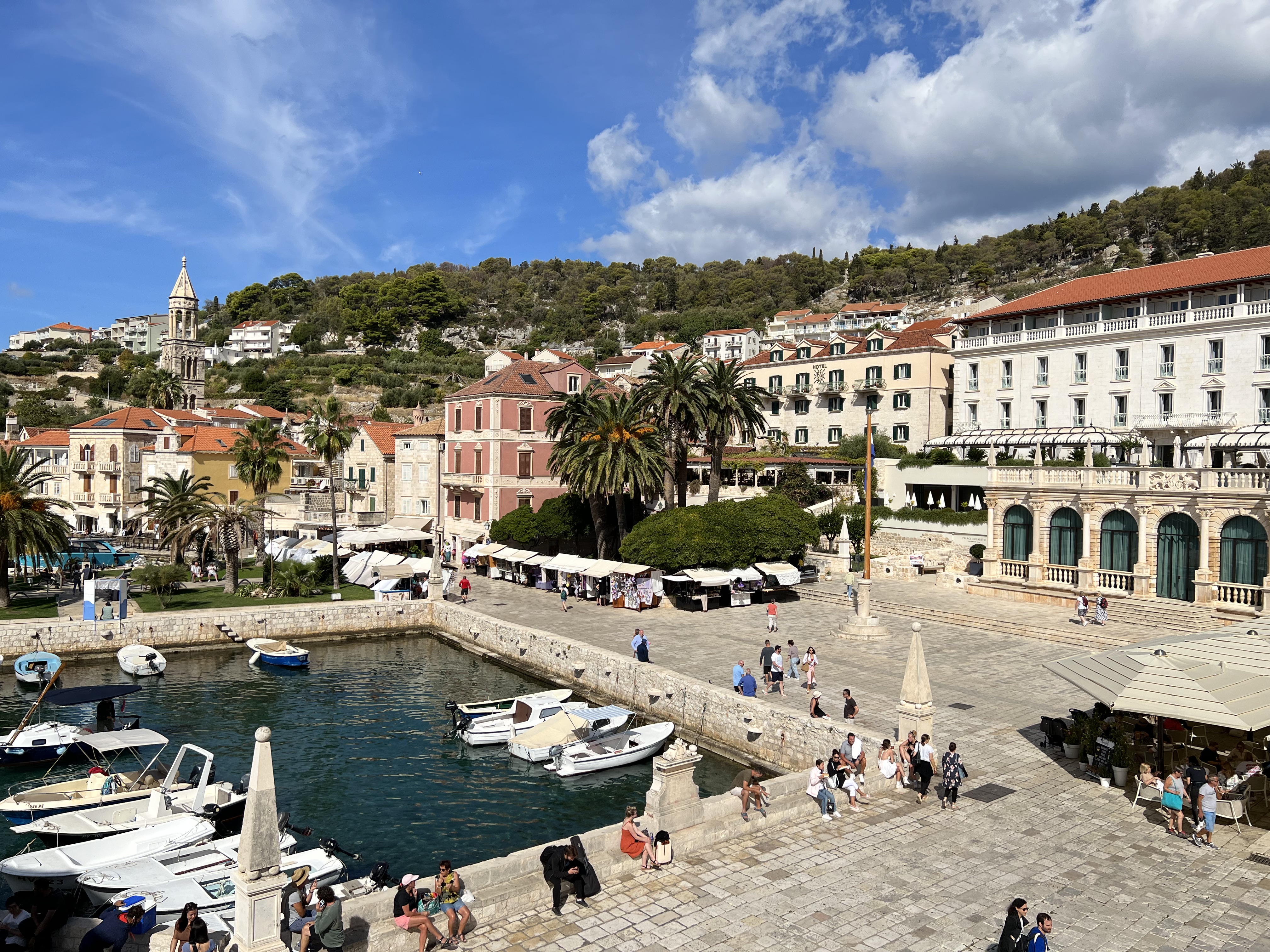
Table of Contents
Hvar island is well worth the 50-minute ferry ride from Split. There are two main ports of entry: Hvar town and Stari Grad.
Date of Visit: September 24, 2022
As my husband, Chris, and I pulled into Hvar town’s sun-baked harbor, my mind flashed back to the first time I glimpsed a jet-setting lifestyle. It was in the 70s when I saw Roger Moore in The Man With The Golden Gun. There was distinctly something James Bondsy about this place.
Imagining James Bond
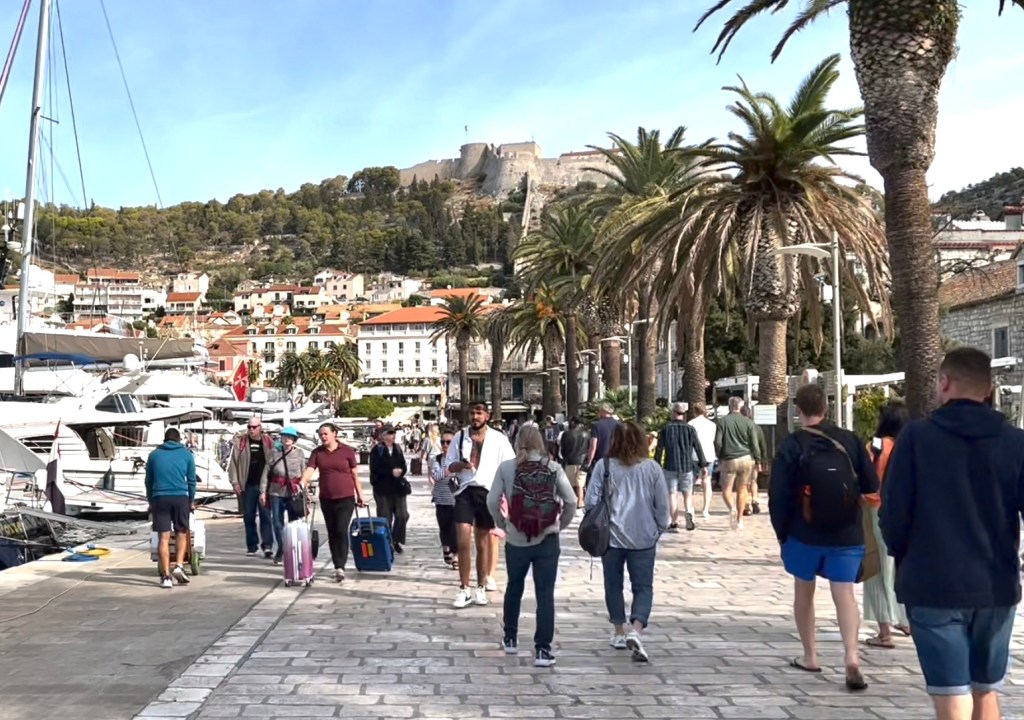
Sleek white yachts, sailing vessels, and polished wooden charter boats lined the port side of the promenade. Cafes and bars peeked from behind tall palm trees across the way.
It was easy to imagine James Bond sipping a martini beside bikini-clad beauties on one of the lavish yachts.
And yet, Croatia has never been the site of a Bond movie. Location scouts did consider nearby Dubrovnik for the last Bond movie, No Time To Die, but in the end, Matera, Italy won on the other side of the Adriatic.
Getting There
It takes 50 minutes to reach Hvar town from Split on a hulking high-speed Kapetan Luka-Krilo catamaran. It’s faster than the car ferries that dock at Stari Grad, the other main port on Hvar.
Our driving company had recommended hiring a private speedboat to visit Hvar and several nearby islands. Had we done that, we would have arrived in style and seen a few more islands. However, €750 (nearly $800) was a hefty price tag. The roundtrip catamaran trip cost less than $70 for two, so we opted for the cat.
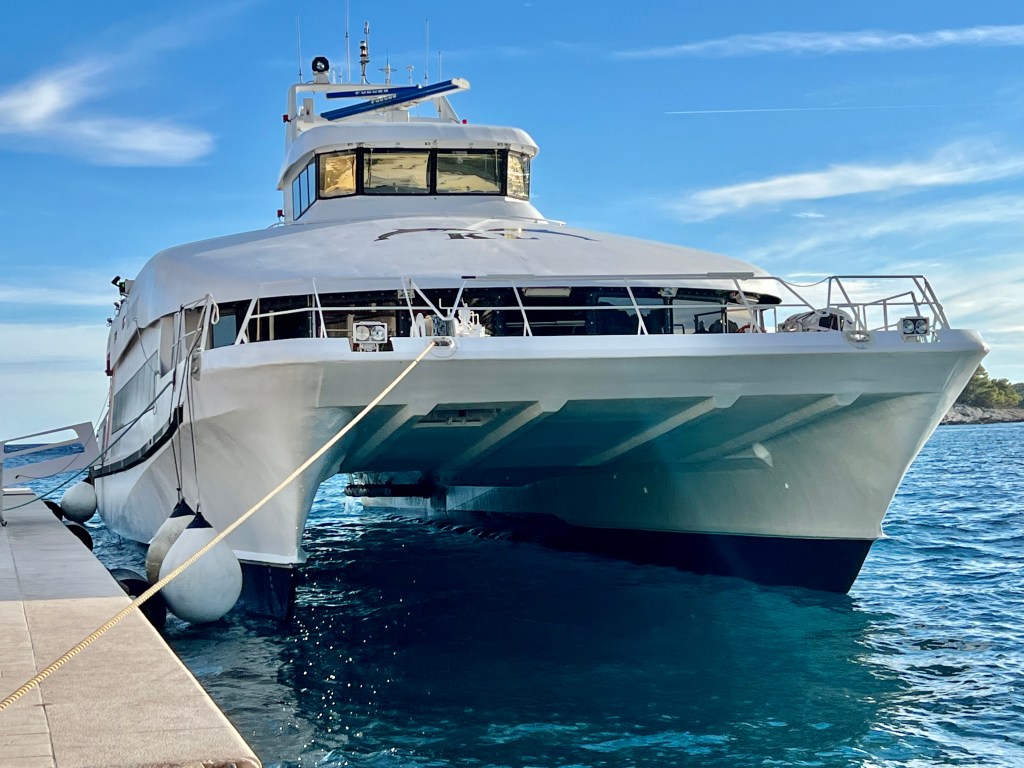
Who Goes There?
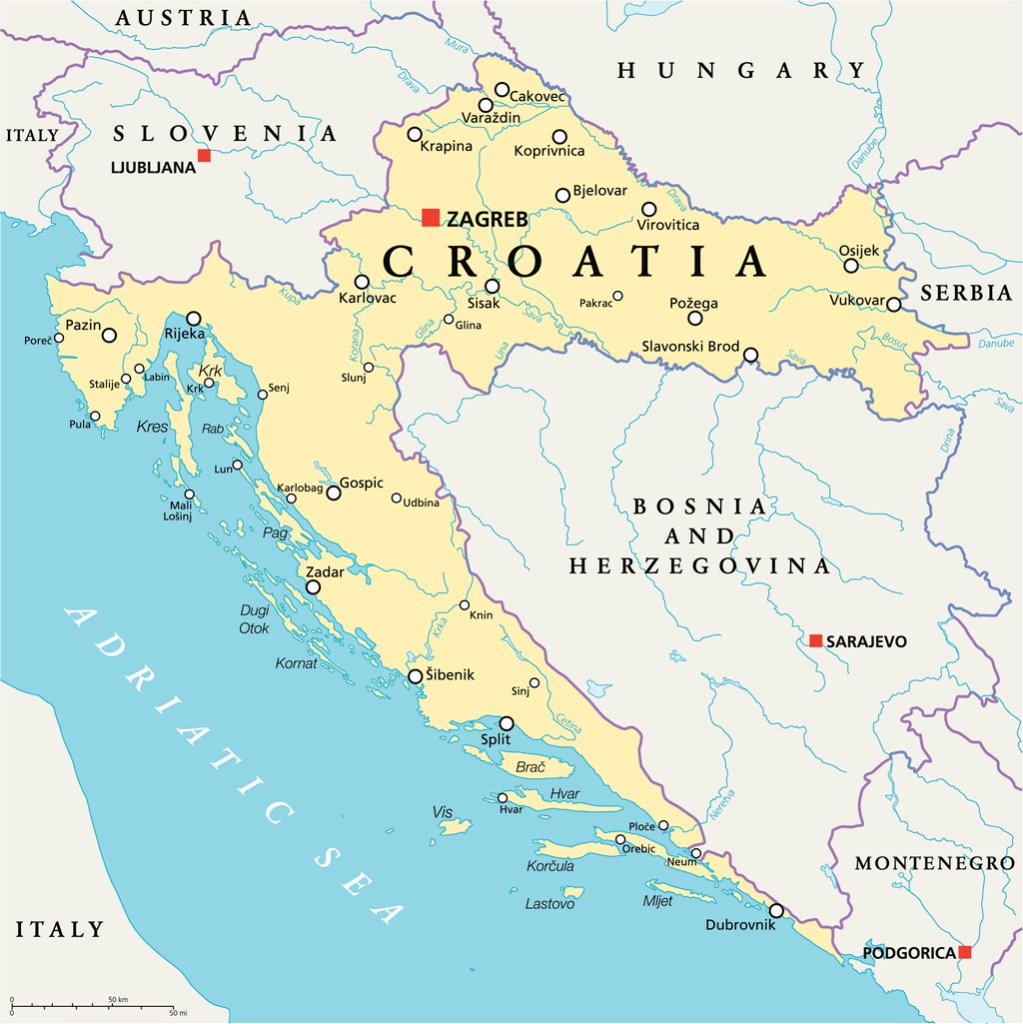
Hvar Island is known as much for all-night parties, bars, and beach clubs as for its 16th-century fort, hidden coves, lavender fields, and vineyards.
Indeed, there’s something for everyone, even the more famous among us.
Since the end of the terrible Yugoslav Wars in the 1990s, Hvar’s been an A-list celebrity destination attracting the likes of Prince Harry, Tom Cruise, and pop stars Bono and Beyonce.
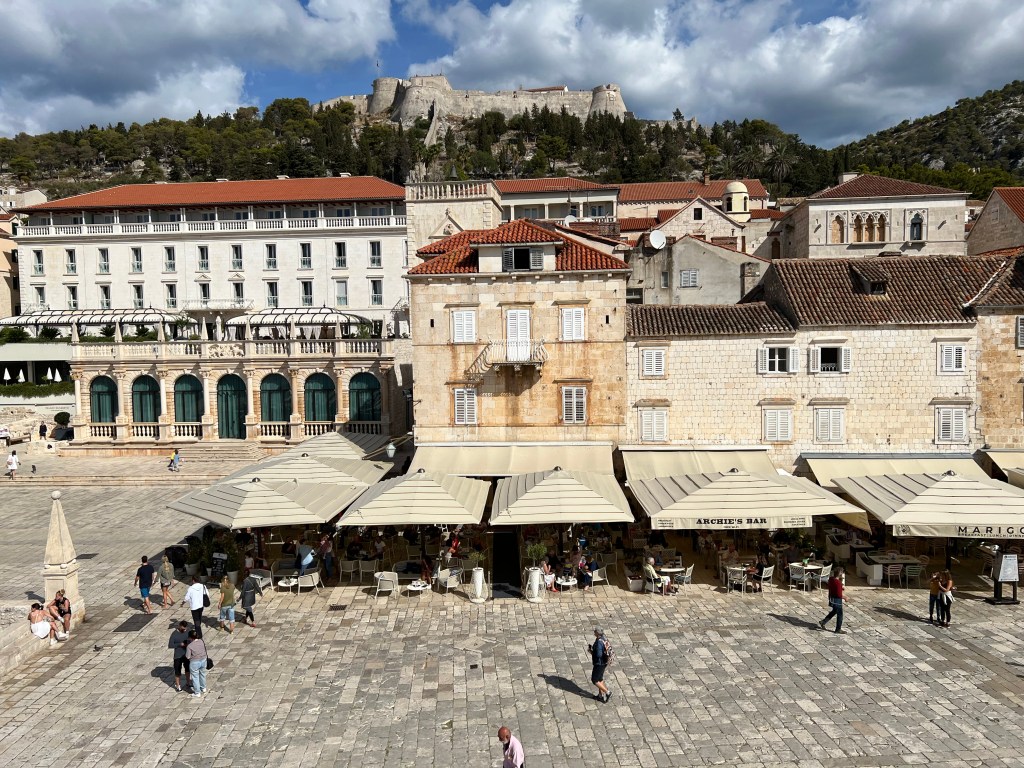
St Stephens Square and The Fortica
The 16th-century Fortica (the locals call it Španjola because the Spanish helped build it centuries earlier) crowns the ridge above St. Stephens Square, where we headed after disembarking. The fortress was at the top of our list of things to do, but an outdoor cafe in the piazza lured us in with its ringside view and intoxicating aroma of rich coffee. We figured a jolt of white coffee (kava s’mlijekom) would help us tackle the looming 328 ft hill.
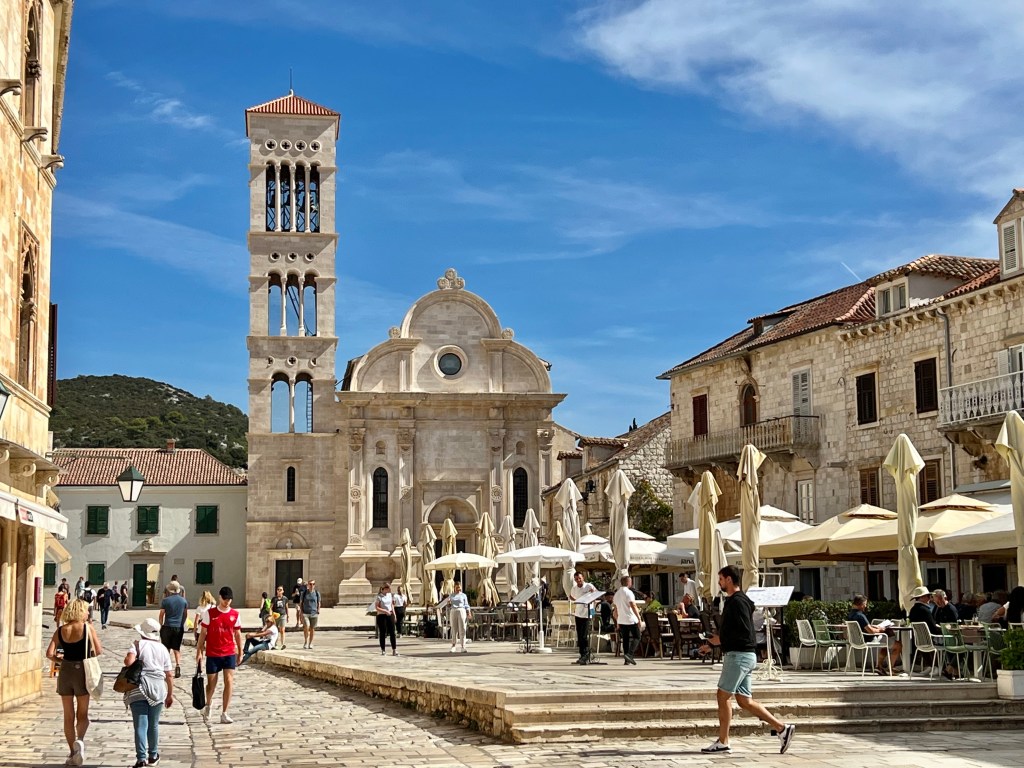
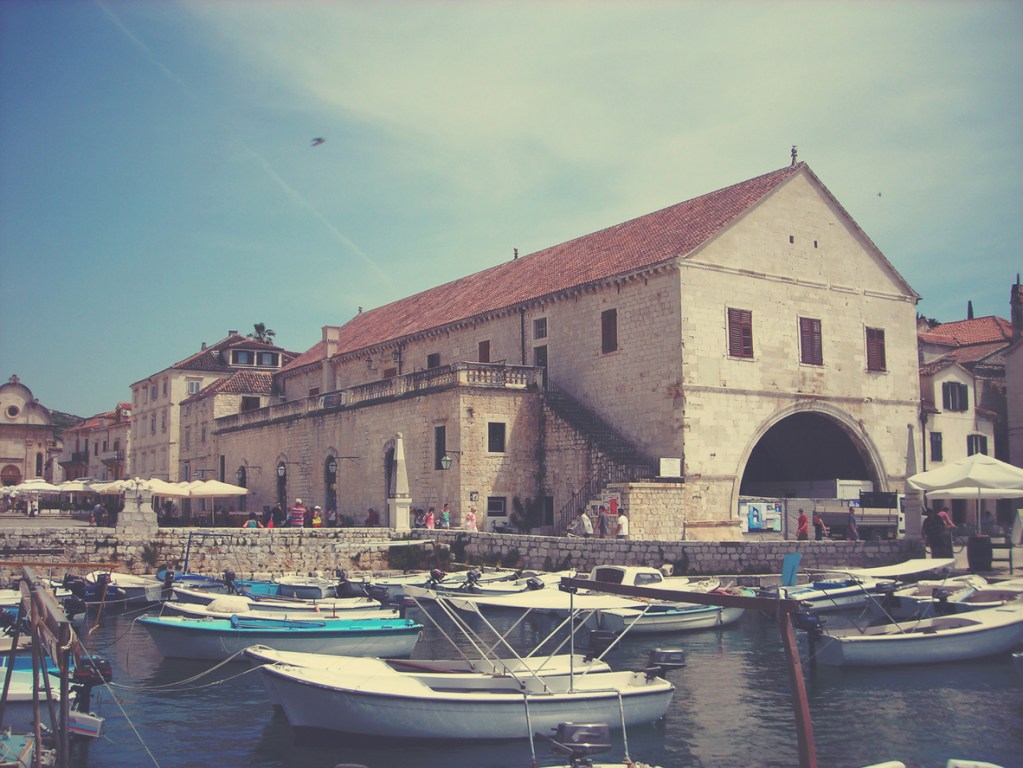
Despite its relatively small size, Hvar attracts ferry loads of tourists. Some come to drink themselves silly or lie on the beaches, and others come to see a bit of history dating back to the 1300s. The Cathedral of St. Stephen is near a row of cafes and the town center’s 14th-century Venetian Arsenal/Historical Shipyard building. Surprisingly, there is a historic public theater tucked inside the Arsenal building. The Venetian and local nobles built the theater in 1612 to appease the lower-class citizens, with whom they clashed violently on numerous occasions. It became Europe’s first public theater when it opened its doors to all social classes.
Activity Central
St. Stephens Square, the heart of Hvar town, is a hive of activity, even in shoulder season. Tourists stroll by, a few pulling roller luggage over the uneven limestone pavers. Locals call out to one other. Dogs trot through the piazza, some on leashes, others dragging them, and a few are strays who have never known a color or leash. They bark their greetings, too. Electric utility vehicles dart around the human and canine obstacles, ferrying supplies and suitcases to hotels of a certain caliber. The sounds echo off the shiny pavers and surrounding buildings.
The climb to the Venetian City Fortress/Fortica is steep. Taxis can take you there if you are not up for the challenge, but we were happy for the exercise even with my bum leg from the horse riding misadventure in Plitvice Lakes. On the way up, we passed tchotchke shops selling lavender sachets, crafts, miniature paintings of Hvar, food, and beach clothing. Cats looked on lazily from the doorways in the narrow passageways. It is a mystery how they thrive alongside stray dogs.
At the top edge of the town, we crossed a paved road to enter a gate that opened to Dr. Josip Avelini Park and a path leading up to the fort. A gravel path snakes uphill through a tranquil Mediterranean herb garden (sage, mint, lavender, rosemary) shaded by pine, cypress, olive, and palm trees. We passed a few vending carts and the abandoned Church of Our Lady of Kruvenica. The church is a photo-worthy stopping point.
Further on, the views of the red rooftops of Hvar town, Hvar harbor, and the small, lush Paklinski island chain are magnificent.
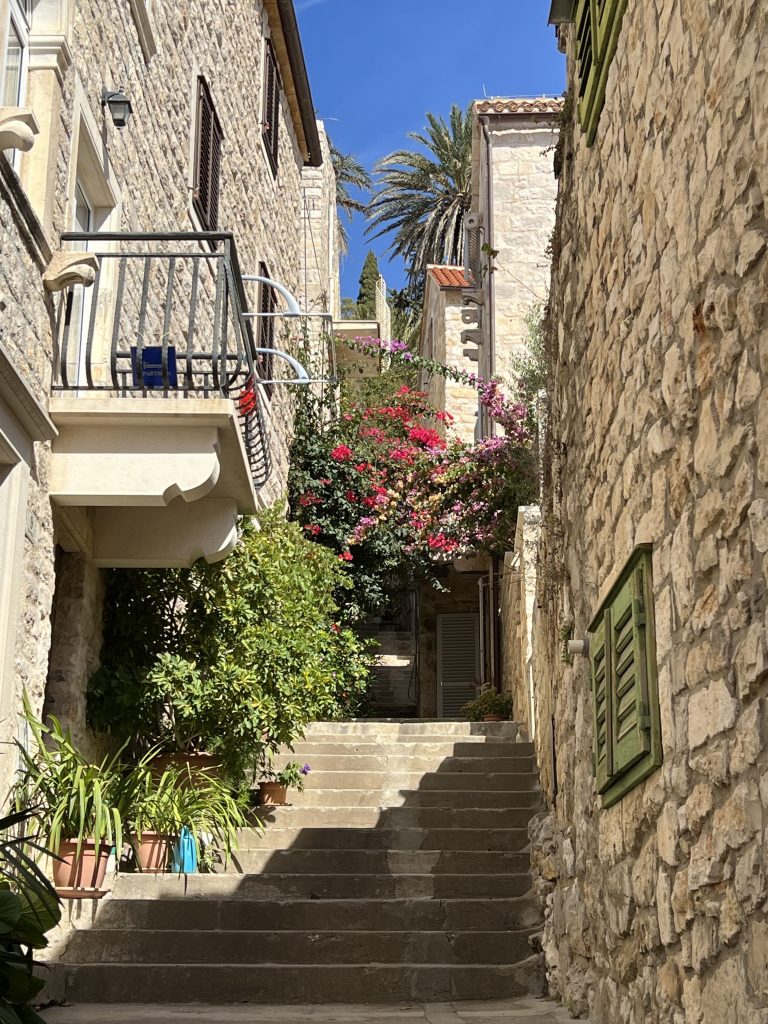
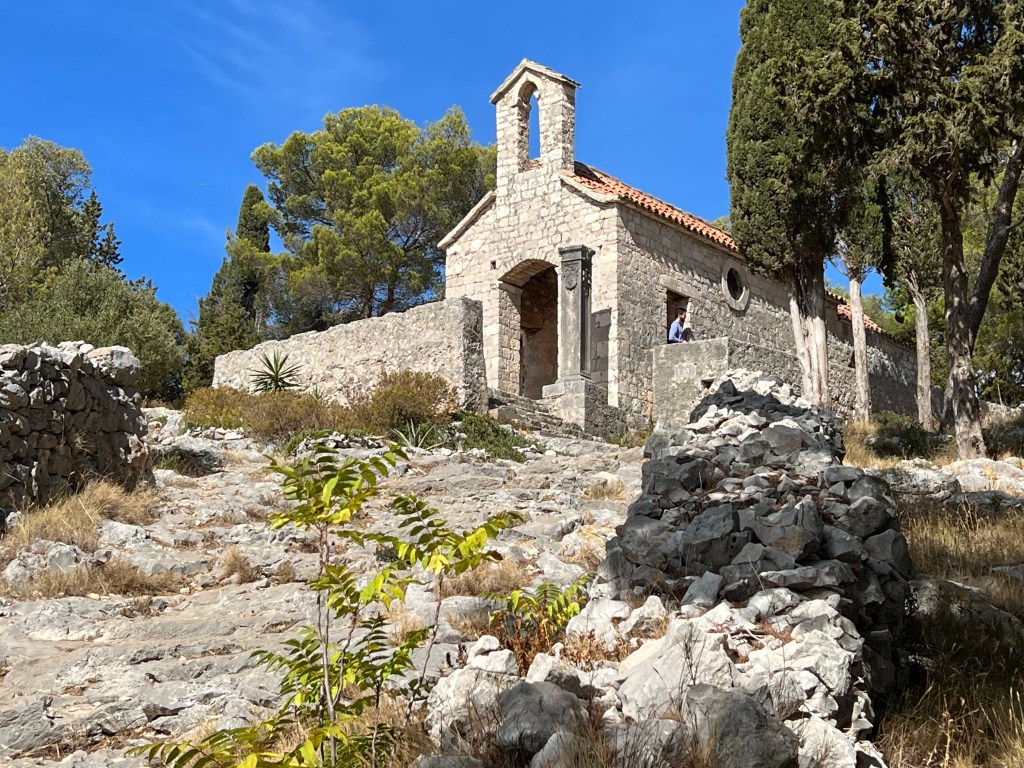
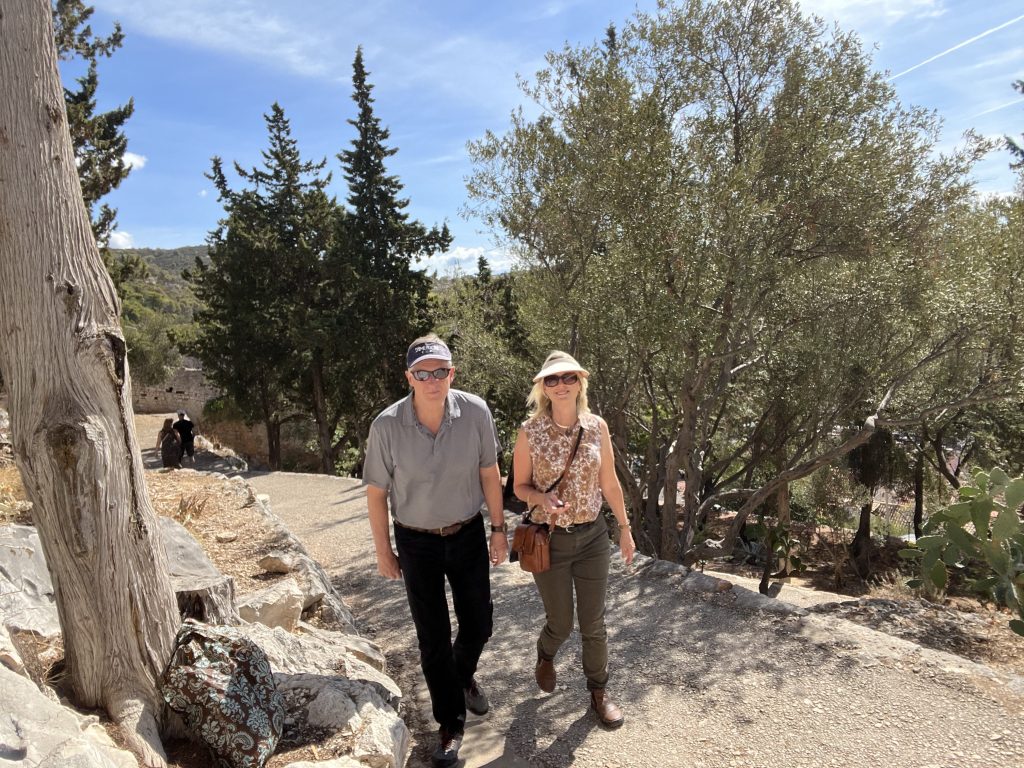
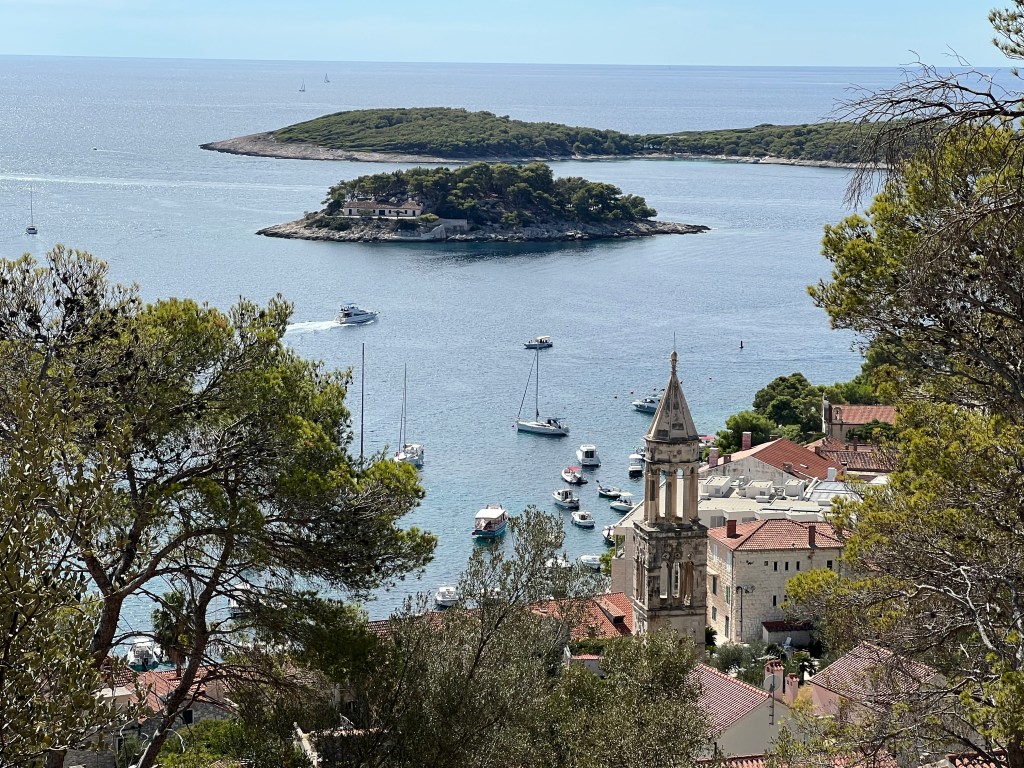
From Pirates to Modern Treasure Hunters
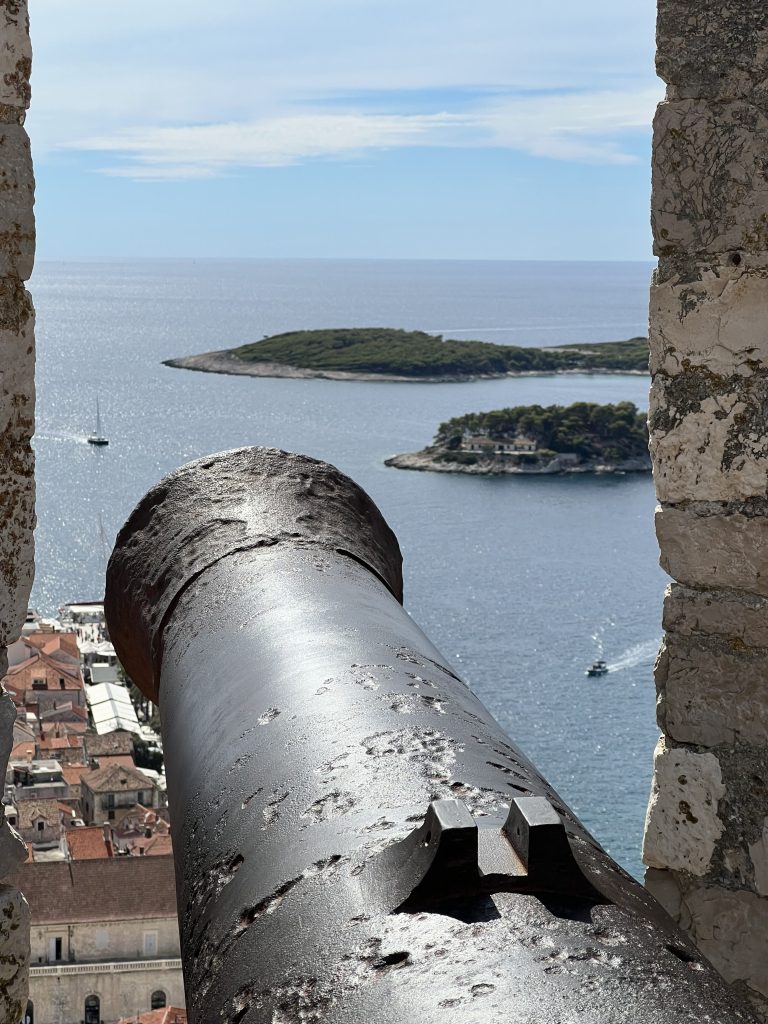
It’s hard to imagine now, but Hvar wasn’t always the idyllic getaway it is today. In the 7th and 8th centuries, pirates routinely plundered the island where Slavic tribes had settled long after the Greeks and Romans. In the 13th Century, Hvar’s residents put their security in the hands of the Venetians in exchange for the safe harbor of the Venetian navy.
The Venetians took several hundred years to complete the fortress for various reasons. Nevertheless, it sheltered the townspeople during an Ottoman attack in 1571.
Lightning struck the gunpowder depot and set it on fire eight years later. It remained in a state of disrepair until the 17th Century. The Austrian Empire made further modifications in the 19th Century.
Today, it is an impressive historical structure that sits above the medieval city walls.
Shipwrecks of Amphorae and Kitchenware
Inside the fort, there are surprisingly few artifacts. Only one room showcases an impressive collection of amphorae, kitchen utensils, and plates recovered from three nearby shipwrecks.
The amphorae are long-necked containers once used to store oil, wine, and sometimes olives and fish. They date back to the 2nd and 1st centuries BC. While unrelated to the fort, they are a part of local history. Historians speculate they were cargo bound for Salona, the one-time Dalmatian capital now called Solin near Split.
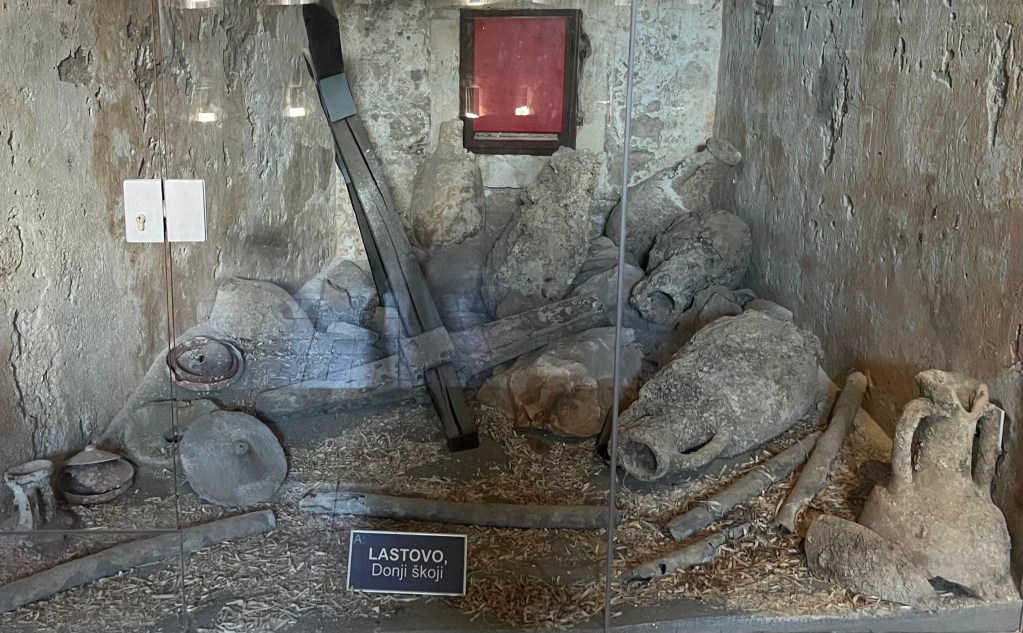
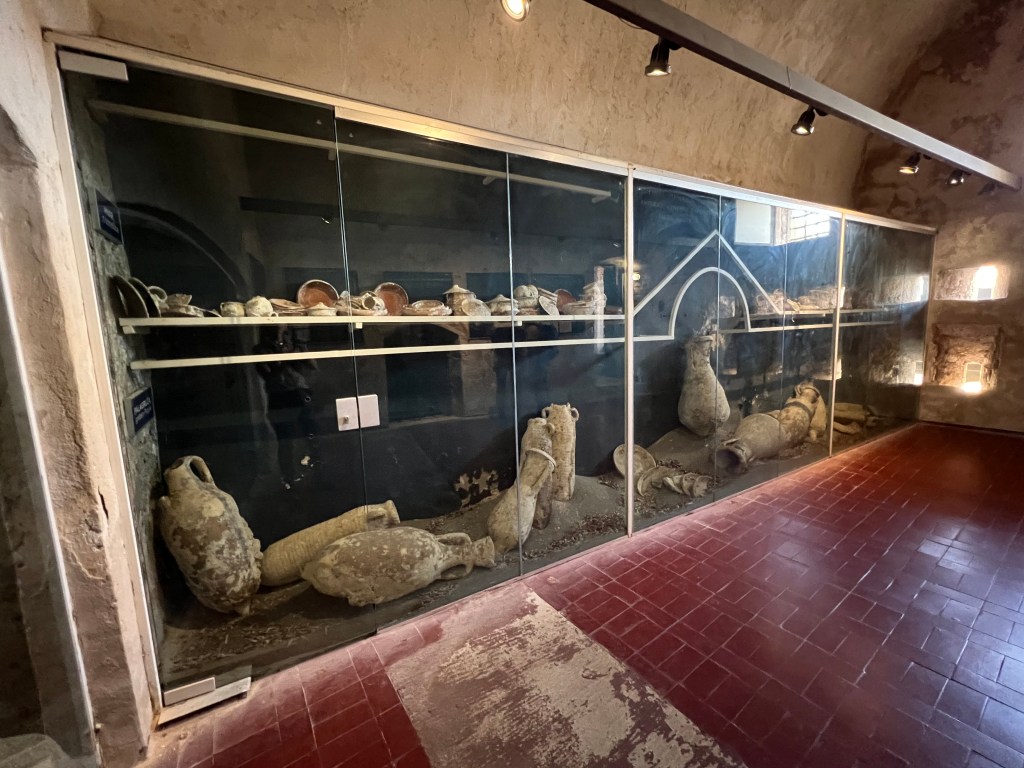
The Dalmatian islands were on the maritime route to ports in the northern Adriatic during the Antiquity, and notoriously, one in 50 voyages ended in a shipwreck. Divers have discovered roughly 200 Roman-era shipwrecks in the Croatian part of the Adriatic Sea. For more information, see Exploring Under Water Heritage in Croatia: A Handbook.
Unscrupulous Divers
With the modernization and sudden accessibility of dive equipment in the early 1970s, many ancient wrecks were suddenly vulnerable to looting, and some of the amphorae ended up in private collections in Hvar, Vis, and possibly Italy, across the sea.
Preservationists placed an iron net over the amphorae embedded in rocks at the bottom of the sea in the Lastovo archipelago to prevent artifacts from being snatched by treasure-seekers or damaged by curious scuba-diving tourists. It didn’t work. In 1995 and 1996, plunderers cut through the nets and made off with many archeological treasures. Fortunately, the amphorae were recovered from that incident and are now displayed in this room (see photos).
The Cat Lady

After we explored the fort, we walked back through Dr. Josip Avelini’s old garden. We stopped to stroke one of the friendly cats lounging beside a lavender sachet kiosk. The vendor, an engaging middle-aged Asian woman, feeds several stray cats daily. Moreover, she had taken them to the local veterinarian to get them fixed. Spaying and neutering are free services in Hvar, but few people bother. That is something we have noticed in many parts of the world. The thought of unwanted kittens and puppies pulled at my heartstrings, but I have heard that the townspeople feed them.
Walking Along The Waterfront
Finally, we reached the bottom of the hill. We strolled along the waterfront from St. Stephen’s Square in the Old Town to the western part of the island, past a quiet park to the big hotels, beachfront swimming areas, and kayak rentals. The elegant Beach Club Hvar looked inviting but appeared closed.
The average age of the tourists there visibly dropped by 20-30 years from that of the Old Town. In the afternoon, this is where the cocktail action is. The drinking starts early at the hotels and cafes and seemingly never ends.
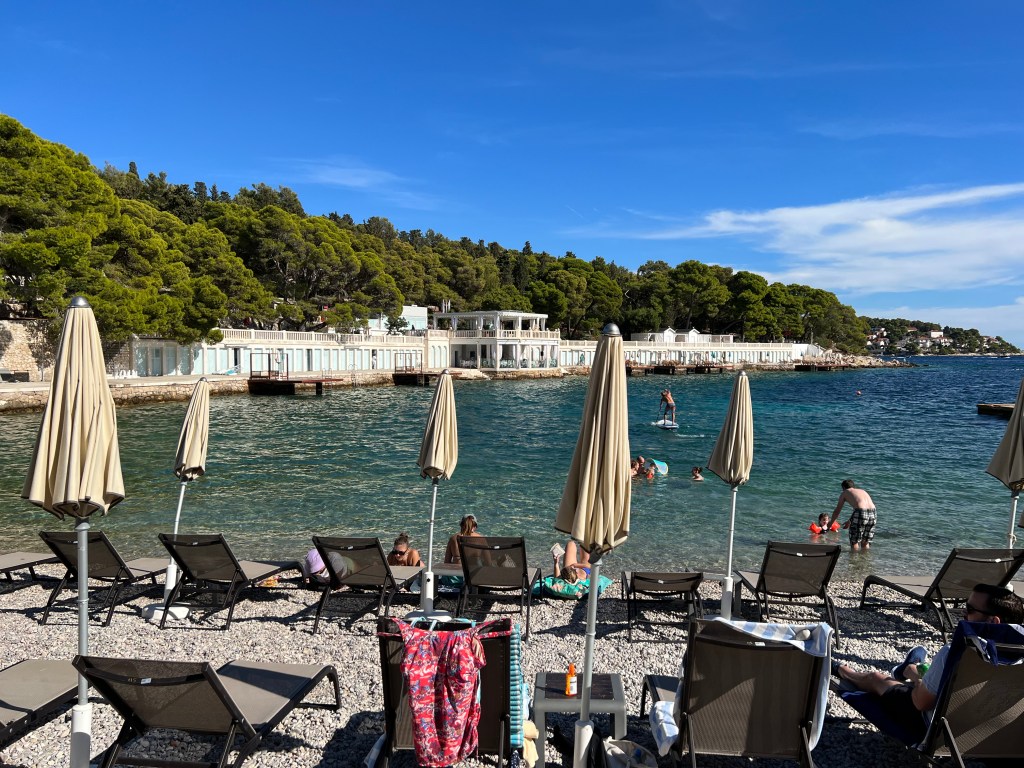
On the way back, Chris and I spotted a succulent stone garden with steps leading to a small rocky beach. We stretched out on two empty lounge chairs beside the crystal clear water and watched boaters pass. What a life.
We would love to have stayed a few days on this island, but this was a day trip, and we had a hotel waiting in Split. Consider a night or two in Hvar if you plan a trip to Croatia. And remember to report back and tell us what you did.
A Good Online Resource
Check out the Hvar Tourist Board’s events, cultural sights, and attractions. It includes bike routes and other adventures, hotels, and transportation. They even offer local recipes for a Mediterranean Diet.
This article is the 14th in my 19-part Balkan series, which began with ‘Road Tripping on the Balkan Peninsula’ in September 2023. There, you will find our itinerary to help you plan your trip.
- Ratings are based on 1) Natural Beauty 2) Unique Activities 3) Old World Charm













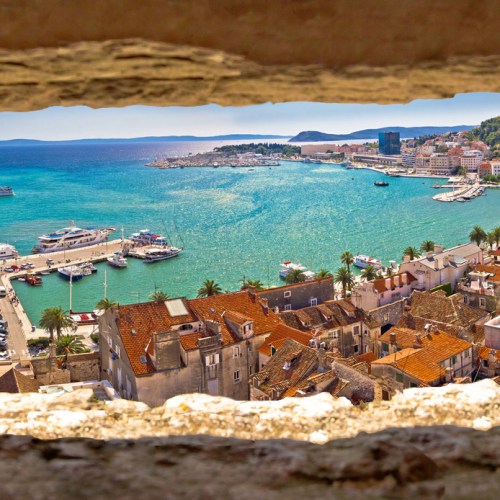
No comment yet, add your voice below!
Discover more from Travel The Four Corners
Subscribe now to keep reading and get access to the full archive.
Continue reading